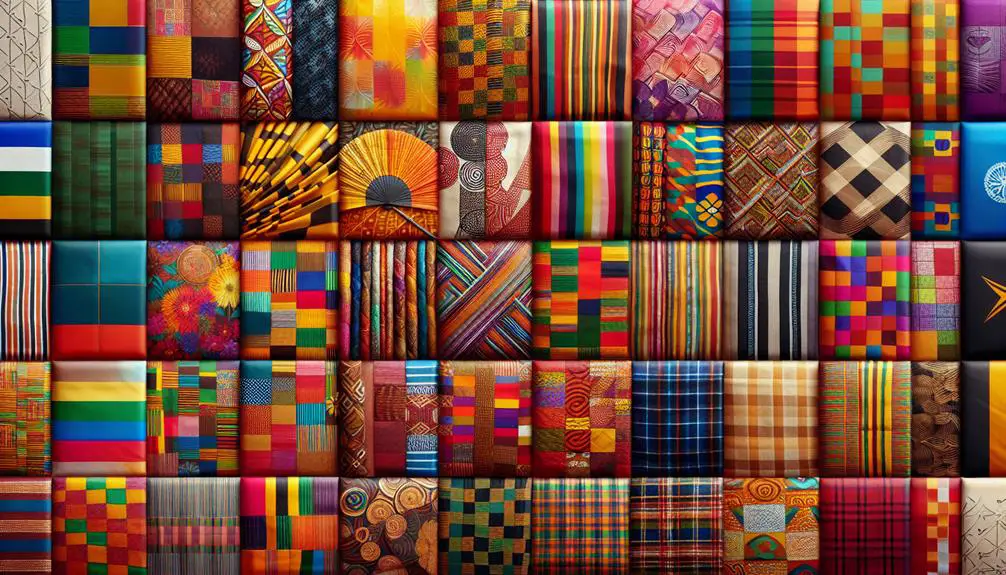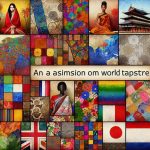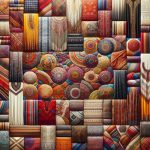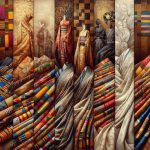Imagine holding a piece of Kente cloth from Ghana; each thread weaves a tale of pride and heritage, much like the intricate stories embedded in fabrics worldwide. You might not realize it, but the patterns and materials in traditional attire from different cultures serve as more than just clothing—they're a living history book. Whether it's the elegance of Japanese kimonos or the vibrant hues of Mexican serape shawls, these textiles communicate identity and legacy. Ever wondered how these fabrics have maintained their cultural relevance across generations? Let's explore the threads that bind communities together.
Table of Contents
Key Takeaways
- Fabrics like Ghanaian Kente cloth symbolize heritage, pride, and cultural identity through intricate weaving techniques and color symbolism.
- Japanese Kimono fabrics showcase nature, seasons, and virtues through traditional dyeing techniques and symbolic patterns.
- Indian Saris represent cultural meanings and regional diversity via vibrant colors and generational weaving traditions.
- Indonesian Batik art uses wax resist dyeing to depict cultural stories and symbolic patterns.
- Moroccan Berber weaving features vibrant colors and motifs that express connections to ancestors and the landscape.
Kente Cloth of Ghana
Celebrated for its vibrant colors and intricate patterns, Kente cloth stands as a symbol of Ghanaian heritage and pride. When you explore the world of Kente, you'll uncover a rich tapestry of meaning woven into each piece. The color symbolism is profound: gold represents wealth and status, green signifies growth and renewal, while blue embodies peace and harmony. Each shade isn't just a visual delight; it's a narrative thread in the story of Ghana's cultural heritage.
Mastering Kente weaving techniques involves understanding the complex process of interlacing silk and cotton threads on a loom. This age-old craft demands precision and dedication, passed down through generations. The patterns themselves, known as 'adwene asa' or 'my skill is exhausted,' showcase the weaver's prowess and creativity.
In Ghana, Kente isn't just fabric; it's ceremonial attire that graces significant events like weddings, graduations, and royal ceremonies. Donning Kente cloth is a powerful statement of identity and respect for tradition. When you wear Kente, you're not merely adorning yourself; you're participating in a cultural legacy that's rich, intricate, and deeply meaningful.
Japanese Kimono Fabrics
When you explore Japanese kimono fabrics, you'll notice the intricate traditional dyeing techniques that bring each piece to life.
These fabrics also feature symbolic patterns and motifs that carry deep cultural meanings.
Understanding these elements helps you appreciate the artistry and heritage embedded in every kimono.
Traditional Dyeing Techniques
Among the many intricate traditions in Japanese culture, the art of dyeing kimono fabrics stands out for its beauty and meticulous craftsmanship. You're not just observing a fabric; you're witnessing a piece of cultural heritage. Using natural dyes derived from plants, minerals, and even insects, artisans achieve a spectrum of colors that are both vibrant and long-lasting. These dyes not only color the fabric but also connect you to ancient traditions that have been passed down through generations.
One of the most enchanting techniques you'll encounter is tie-dyeing, known in Japan as Shibori. This method involves folding, twisting, or bunching the fabric before applying the dye, resulting in intricate patterns that are unique to each piece. The process is as follows:
- Preparing the Fabric: The fabric is carefully washed and treated to ensure it absorbs the dyes evenly.
- Applying the Dye: Artisans use natural dyes, such as indigo, to create rich, deep hues.
- Setting the Dye: The fabric is steamed or boiled to lock in the colors.
Mastering these techniques requires not only skill but also a deep understanding of the materials and their historical significance. Each kimono you encounter tells a story, woven and dyed with threads of tradition.
Symbolic Patterns and Motifs
In Japanese kimono fabrics, symbolic patterns and motifs carry deep cultural meanings that often tell stories of nature, seasons, and virtues. You'll find that each pattern is meticulously designed, reflecting the rich traditions of cultural storytelling and color symbolism. For instance, cherry blossoms signify the ephemeral beauty of life, while cranes symbolize longevity and good fortune.
Understanding these motifs requires appreciating their spiritual significance. Traditional craftsmanship ensures that every stitch and dye captures the essence of these symbols. The colors aren't arbitrary either; they're chosen to amplify the motif's meaning. For example, red signifies happiness and prosperity, while white represents purity and mourning.
Here's a quick guide to some common motifs and their meanings:
| Motif | Spiritual Significance | Color Symbolism |
|---|---|---|
| Cherry Blossoms | Ephemeral beauty | Pink (Romance) |
| Cranes | Longevity, Good fortune | White (Purity) |
| Bamboo | Resilience, Strength | Green (Growth) |
| Waves | Power of nature, Fluidity | Blue (Calmness) |
Indian Sari Textiles
The vibrant and intricate designs of Indian sari textiles showcase the rich cultural heritage and craftsmanship of the region. When you explore the world of saris, you'll uncover layers of meaning in every shade and weave.
Color symbolism is essential; for instance, red signifies purity and is often chosen for weddings, while white denotes mourning.
The weaving techniques used are a tribute to the skills passed down through generations. From the shimmering Kanchipuram silks of Tamil Nadu to the delicate Chanderi weaves of Madhya Pradesh, each style tells a unique story. The expertise of artisans in creating these textiles is evident in the intricate patterns and the quality of the fabric.
Regional variations and the historical evolution of sari textiles are equally intriguing. You'll find a diversity that ranges from the elaborate Banarasi saris of Varanasi to the simple, yet graceful, handloom saris of Bengal. This regional diversity is a reflection of India's vast cultural mosaic.
Here's a closer look at the Indian sari textiles:
- Color Symbolism: Red for weddings, white for mourning.
- Weaving Techniques: Kanchipuram silk, Chanderi weave.
- Regional Variations: Banarasi saris, Bengal handloom saris.
Chinese Silk Brocade
When you explore Chinese Silk Brocade, you'll uncover its rich historical importance and intricate artistic techniques.
This luxurious fabric has been cherished for centuries, symbolizing wealth and craftsmanship.
Historical Importance
Chinese silk brocade, with its intricate designs and rich textures, has played a pivotal role in the country's history and culture. You can trace the cultural evolution of China through its fabric production, where silk brocade stands out as a symbol of sophistication and power.
The process of creating these luxurious textiles was a guarded secret, contributing significantly to the historical importance of the Silk Road. This ancient trade route facilitated not just the exchange of goods, but also ideas and cultures, marking silk brocade as a cornerstone of textile trade.
To appreciate its historical importance, consider the following points:
- Imperial Symbolism: Silk brocade was often reserved for royalty and nobility, signifying status and power. Emperors wore garments made from this fabric, embedding it deeply into the political and social hierarchy of ancient China.
- Economic Influence: The demand for silk brocade fueled economic growth, making it a critical export product. Its value was so high that it was sometimes used as currency.
- Cultural Exchange: Through the Silk Road, silk brocade introduced Chinese artistry to the world, influencing textile practices across Asia and Europe.
Artistic Techniques
Mastering the art of silk brocade involves meticulous craftsmanship and techniques passed down through generations. As you explore this intricate craft, you'll discover that each piece isn't just a fabric but a tapestry of history and tradition.
The colorful embroidery techniques used in Chinese silk brocade aren't merely decorative; they symbolize cultural significance in weaving traditions that date back to ancient dynasties. You'll start with selecting the finest silk threads, ensuring they're both strong and delicate. Next, learn the various stitches that form the complex patterns, often depicting dragons, phoenixes, and floral motifs.
These designs aren't random; each holds a unique cultural meaning, reflecting prosperity, longevity, and good fortune. To truly master these techniques, focus on the precision of your weaving. Each thread must be carefully placed to achieve the desired texture and sheen.
Don't rush this process; patience and practice are key. Incorporate traditional tools like the loom and shuttle to maintain authenticity in your work.
Scottish Tartan Patterns
Scottish tartan patterns, with their distinct crisscrossed designs, represent the rich heritage and identity of various clans. These iconic motifs are more than just fabric; they're symbols of Scottish heritage that have stood the test of time. You'll find that modern fashion has embraced tartan in ways that harmoniously blend tradition with contemporary design trends.
Tartan symbolism runs deep, often reflecting the lineage and geographical roots of the wearers. In today's world, these patterns have transcended their traditional roles to become staples in contemporary design trends. Whether it's on a stylish scarf or a chic blazer, tartan's versatility is undeniable.
To truly appreciate the significance of tartan, consider the following:
- Clan Identity: Each tartan pattern is unique to a specific clan, serving as a visual representation of family lineage and heritage.
- Modern Fashion: Tartan has been seamlessly integrated into modern fashion, making appearances on runways and in high-street stores alike.
- Global Influence: The adoption of tartan patterns in different cultures highlights their universal appeal and timeless charm.
Understanding Scottish tartan patterns enriches your appreciation for how fabrics can embody both history and modernity.
Indonesian Batik Art
You'll find Indonesian Batik Art fascinating with its intricate traditional techniques.
Each pattern carries symbolic meanings that reflect cultural stories and beliefs.
Understanding these patterns will give you a deeper appreciation of this art form's cultural significance.
Traditional Batik Techniques
Indonesian Batik art involves intricate techniques that have been passed down through generations, showcasing the rich cultural heritage of the region.
You'll find that the essence of Batik lies in its unique process of wax resist dyeing, which allows artisans to create intricate patterns and traditional designs. Mastering Batik requires precision, patience, and an eye for detail.
To begin your journey into traditional Batik techniques, here are three essential steps:
- Applying the Wax: Using a tool called a 'canting,' you'll carefully apply hot wax to the fabric, following the traditional designs. This wax will act as a barrier, preventing the dye from penetrating the fabric in these areas.
- Dyeing the Fabric: Once the wax is set, you'll immerse the fabric in dye. The unwaxed areas will absorb the dye, while the waxed sections remain untouched, creating a stark contrast and highlighting the intricate patterns.
- Removing the Wax: After dyeing, you need to remove the wax by boiling the fabric or using an iron. This reveals the final design, showcasing the beautiful traditional motifs and the expertise required in the process.
Symbolism in Patterns
Once you've mastered the traditional techniques, you'll find that the patterns in Batik art carry profound symbolic meanings, reflecting the cultural stories and values of Indonesia.
Each motif you create isn't just a design but a narrative woven into fabric. For instance, the 'Parang' pattern, with its bold, diagonal lines, represents strength and resilience. When you choose colors, you're not merely selecting hues; you're invoking color symbolism. In Javanese Batik, white symbolizes purity, while dark blue conveys wisdom.
Geometric designs in Batik are more than aesthetically pleasing shapes; they hold spiritual significance. The 'Kawung' motif, resembling the cross-section of a palm fruit, symbolizes a reminder to stay humble and grounded.
As you explore further, you'll see how these designs encapsulate cultural meanings, serving as visual metaphors for life's principles and philosophies.
Your journey into Batik art isn't just about fabric and dye; it's about understanding a rich cultural tapestry.
Mexican Serape Shawls
Mexican serape shawls, with their vibrant colors and intricate patterns, are a reflection of the rich cultural heritage of Mexico. These shawls epitomize colorful craftsmanship, showcasing the skills and traditions passed down through generations. Each piece is a reflection of the cultural heritage of the regions where they're crafted, often featuring geometric patterns and vivid hues that tell stories of community and history.
When you wear a serape, you're not just making a fashion statement; you're embracing the handwoven beauty that defines this iconic garment. The meticulous process of creating a serape involves weaving wool or cotton on a loom, often taking weeks to complete. This dedication to detail is evident in the final product, making each shawl unique and treasured.
To truly appreciate Mexican serape shawls, consider the following:
- Historical Significance: Originating from the Mexican state of Tlaxcala, these shawls have been worn for centuries, serving both practical and ceremonial purposes.
- Symbolic Patterns: The designs often have symbolic meanings, representing elements of nature, spirituality, and community life.
- Versatile Use: Beyond being a fashion statement, serapes can be used as blankets, table coverings, or even wall hangings, showcasing their multifunctional appeal.
Moroccan Berber Weaving
Moroccan Berber weaving, with its intricate patterns and vibrant colors, showcases the rich cultural traditions of the Berber people. These textiles aren't just beautiful; they're a profound expression of tribal traditions and cultural heritage.
You'll find every piece tells a story, woven meticulously by hand using techniques passed down through generations. The geometric designs and symbolic motifs reflect the weavers' connection to their ancestors and landscape.
When diving into Berber weaving techniques, you'll notice the impressive skill involved. Artisans use a variety of materials, from wool to natural dyes, creating textiles that are both durable and aesthetically pleasing. Each rug's creation is a laborious process, requiring immense patience and precision.
You'll appreciate the distinctiveness of every piece, recognizing that no two are exactly alike.
Understanding the cultural heritage embedded in this textile artistry enriches your appreciation for these masterpieces. Berber rugs are more than mere decorations; they're cultural artifacts that embody the spirit and history of the Berber people.
Turkish Kilim Rugs
Just as Moroccan Berber weaving captures the essence of its culture, Turkish Kilim rugs offer a window into the rich traditions and artistry of Anatolia. You'll find that these rugs are more than just decorative items; they're steeped in history and cultural symbolism. Crafted using ancient weaving techniques passed down through generations, each Kilim tells a unique story.
To truly appreciate Turkish Kilim rugs, consider these key aspects:
- Weaving Techniques:
The flat-weave technique, known as 'kilim,' involves interweaving the warp and weft strands to create intricate patterns. This method not only guarantees durability but also allows for detailed geometric designs.
- Cultural Symbolism:
Each motif in a Kilim rug holds specific meaning. For instance, the 'elibelinde' pattern represents fertility and motherhood, while the 'koçboynuzu' symbolizes strength and heroism.
- Regional Variations:
Different regions in Turkey produce Kilims with distinct characteristics. Anatolian Kilims are renowned for their bold colors and geometric patterns, while those from the Aegean region often feature more subdued hues and floral designs.
Nigerian Aso-Oke Cloth
In Nigeria, Aso-Oke cloth stands out as a vibrant symbol of Yoruba culture and heritage. When you explore its significance, you'll find that Aso-Oke isn't just fabric; it's a tribute to the rich weaving traditions that have been passed down through generations. Crafted meticulously by artisans, this cloth embodies both skill and cultural pride.
You'll often see Aso-Oke in various cultural ceremonies, where it plays a leading role. Whether it's weddings, naming ceremonies, or festivals, Aso-Oke's elaborate patterns and vibrant colors make it a focal point. Men typically wear it as agbada or fila, while women use it for iro, buba, and gele, highlighting its versatility and elegance.
Understanding Aso-Oke means acknowledging the labor-intensive process behind it. The weaving traditions involve handlooms, where each thread is carefully placed to create intricate designs. This dedication guarantees that every piece of Aso-Oke is unique, carrying personal and communal stories within its threads.
When you embrace Aso-Oke, you're not just wearing a beautiful garment; you're participating in a cultural legacy that celebrates artistry, history, and the Yoruba community's enduring spirit.
Frequently Asked Questions
How Do Different Cultures Use Fabrics in Traditional Ceremonies and Rituals?
You'll find that different cultures use fabrics in traditional ceremonies and rituals by incorporating textile symbolism and ceremonial attire. Each fabric choice and design carries deep meaning, reflecting cultural heritage and spiritual beliefs.
What Are the Environmental Impacts of Fabric Production Around the World?
Imagine the Earth gasping for breath as fabric production leaves a hefty carbon footprint. You can reduce this impact by embracing sustainable practices, ensuring the planet thrives while you enjoy your textiles.
How Has Globalization Influenced Traditional Fabric-Making Techniques?
Globalization's reshaped traditional fabric-making techniques. You'll notice artisanal techniques blending with modern practices to meet global market demands. This fusion can enhance craftsmanship, but it risks eroding cultural uniqueness if not carefully managed.
What Role Do Fabrics Play in Modern Fashion Across Various Cultures?
You'll find that fabrics in modern fashion serve as both a canvas and a statement. Fashion trends often draw from cultural influences, making fabrics integral to expressing identity and heritage in contemporary styles.
How Do Fabric Patterns Convey Social or Political Messages Globally?
Fabric symbolism speaks subtly, sending significant global messages. You'll notice patterns that portray political protests or social solidarity. From African kente to Scottish tartans, these designs deliver deep, deliberate statements about identity, resistance, and unity.
- Recycling Nonwoven Fabrics: Is It Possible? - July 11, 2025
- Recycling Nonwoven Fabrics: Is It Possible? - July 11, 2025
- Recycling Nonwoven Fabrics: Is It Possible? - July 11, 2025







